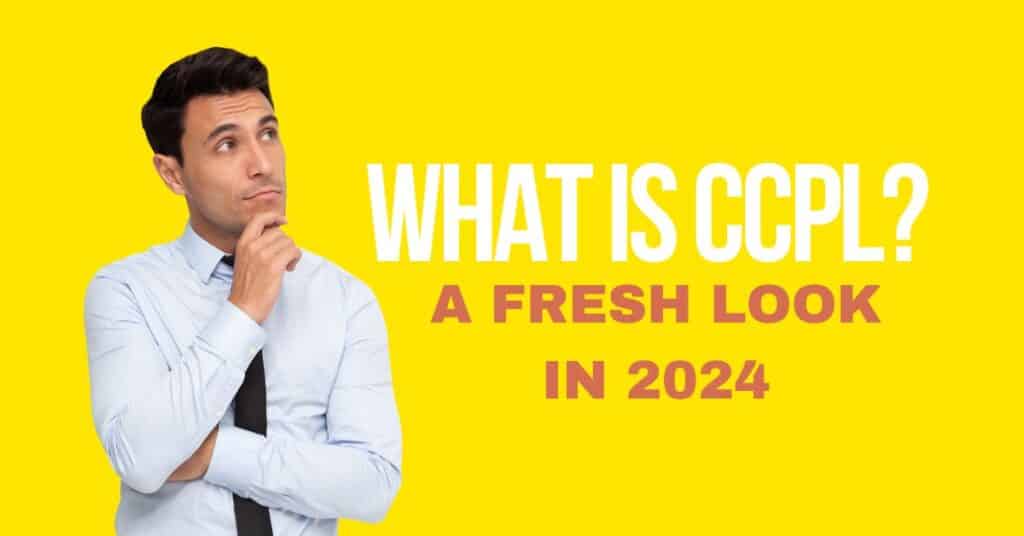What is CCPL and Why does it Matters? A Fresh Look in 2024
Content Creation and Public Licensing (CCPL) is a revolutionary concept that has gained prominence in recent years. CCPL is born from the idea of democratizing content, allowing creators to share their work with the world while retaining certain rights. The term refers to a set of licensing models that enable creators to dictate how their work can be used, shared, and adapted by others. Originating from the broader open-source movement, CCPL emphasizes collaboration and community-driven content creation.
- Importance in the Digital Age
In this era of rapid digital transformation, the importance of CCPL cannot be overstated. As the internet becomes a hub for diverse content, CCPL emerges as a key player in shaping how information is disseminated and consumed. It provides creators with the flexibility to share their work without traditional copyright constraints, fostering a more open and collaborative digital landscape. In a world where information flows freely, CCPL serves as a catalyst for innovation, enabling a dynamic exchange of ideas.
- Brief Overview of CCPL’s Role in Content Creation
A brief exploration of CCPL reveals its multifaceted role in content creation. It goes beyond traditional copyright models by allowing creators to specify the permissions granted to others. Whether it’s sharing, remixing, or commercial use, CCPL empowers content creators to define the terms under which their work can be utilized. This approach not only nurtures creativity but also facilitates the growth of online communities centered around shared interests. In essence, CCPL acts as a bridge between individual creativity and the collective potential of the digital community.

What is CCPL?
CCPL, which stands for Content Creation and Public Licensing, is a revolutionary approach to content sharing. At its core, CCPL redefines how creators can license their work, offering a more open and collaborative framework. This model allows creators to retain certain rights while sharing their content with the public. The term itself encapsulates the dual nature of this concept: it involves both the act of creating content and the public licensing that governs its usage.
- How CCPL Differs from Traditional Content Licensing
The distinction between CCPL and traditional content licensing lies in the flexibility it offers to creators. Unlike traditional models where strict copyright rules apply, CCPL enables creators to dictate how others can use, share, and build upon their work. This departure from rigid copyright structures fosters a more dynamic and inclusive environment for content creation. CCPL embodies a shift towards democratizing content, allowing a broader audience to engage with and contribute to creative works.
- Key Features and Components of CCPL
Understanding CCPL involves recognizing its key features and components. At its foundation, CCPL provides creators with a toolkit to specify the permissions associated with their content. These permissions encompass a spectrum of actions, from simple sharing to more complex activities like remixing or commercial use. By offering this granularity, CCPL empowers creators to tailor licensing terms to their preferences. This flexibility is a cornerstone of CCPL, promoting a balance between protecting creators’ rights and encouraging collaborative content development.
Why is Clipping Path Relevant?
CCPL plays a pivotal role in shaping the visibility and credibility of digital content. By embracing CCPL, creators unlock the potential for broader exposure as their work can be shared and accessed by a wider audience. This increased visibility not only amplifies the reach of content but also enhances its credibility. When content is freely shared under CCPL, it contributes to a culture of transparency, making the origin and intentions of the content more apparent and trustworthy.
- How CCPL Enhances Collaboration and Community Building
One of the standout features of CCPL is its ability to foster collaboration and community building. Unlike traditional content licensing that may hinder collaborative efforts, CCPL encourages creators to work together. Through shared licensing agreements, creators can collectively contribute to projects, forming a vibrant ecosystem of shared ideas and diverse perspectives. This collaborative spirit not only enriches the content but also strengthens the bonds within communities built around common interests.
- Examples of Successful Strategies with CCPL
The relevance of CCPL becomes even more evident when examining successful strategies implemented by various creators and organizations. Many digital platforms, such as Wikimedia Commons, leverage CCPL to curate a vast repository of freely usable images and media. This approach has not only democratized access to visual content but has also established these platforms as go-to sources for high-quality, openly licensed materials. These examples showcase how embracing CCPL can lead to strategic advantages in content creation and distribution.

How to Implement Clipping Path in Your Business
Implementing CCPL in your business begins with a clear understanding of licensing models. Consider how CCPL aligns with your content strategy and the rights you wish to retain. For those offering Clipping Path Services, integrating CCPL involves defining how your visual content can be utilized, ensuring that the licensing model chosen aligns with your business goals and client expectations.
- Best Practices for Creating CCPL-Compatible Content
When engaging in Clipping Path Services, adopting best practices for creating CCPL-compatible content is crucial. This involves incorporating clear licensing information into your creative work, specifying usage permissions, and providing attribution details. Emphasize transparency in your content creation process, ensuring that clients and collaborators are aware of the licensing terms associated with the visuals you produce.
- Examples of Successful Strategies with CCPL
The relevance of CCPL becomes even more evident when examining successful strategies implemented by various creators and organizations. Many digital platforms, such as Wikimedia Commons, leverage CCPL to curate a vast repository of freely usable images and media. This approach has not only democratized access to visual content but has also established these platforms as go-to sources for high-quality, openly licensed materials. These examples showcase how embracing CCPL can lead to strategic advantages in content creation and distribution.

Benefits of Choosing Clipping Path
Opting for Content Creation and Public Licensing (CCPL) offers businesses, particularly those providing Clipping Path Services, unparalleled flexibility in content distribution. CCPL allows creators to specify the permissions granted, providing the freedom to share, modify, and distribute content as desired. For Clipping Path Services providers, this flexibility translates into the ability to reach a wider audience and cater to diverse client needs, ultimately enhancing the business’s online presence.
- Building a Community Through Shared Content
CCPL serves as a catalyst for community building through shared content. Businesses, including those specializing in Clipping Path Services, can leverage CCPL to create a collaborative ecosystem. By encouraging users to engage with and contribute to shared content, a sense of community is cultivated. This communal approach not only strengthens brand identity but also fosters loyalty among clients and collaborators, establishing a supportive network within the industry.
- Legal and Ethical Considerations
In addition to its practical advantages, choosing Clipping Path brings forth crucial legal and ethical considerations. For businesses offering Clipping Path Services, adherence to licensing terms ensures compliance with copyright laws and ethical content practices. Embracing Clipping Path demonstrates a commitment to transparency and responsible content sharing, building trust with clients and users alike. This ethical stance not only safeguards businesses from legal implications but also positions them as responsible contributors to the digital content landscape.
Common Misconceptions About CCPL
In the realm of Clipping Path Services and content creation, there are several misconceptions surrounding Content Creation and Public Licensing (Clipping Path) that need clarification. One common myth is that Clipping Path means giving up all rights to your content, which is untrue. Addressing this misconception involves emphasizing that CCPL allows creators to retain specific rights while sharing content freely. By dispelling such myths, businesses in the Clipping Path Services industry can better understand the nuanced nature of Clipping Path and make informed decisions regarding their content distribution strategy.
- Debunking Misunderstandings Surrounding Clipping Path
Debunking misunderstandings surrounding Clipping Path is essential for businesses, especially those offering Clipping Path Services, to harness its benefits effectively. Some may believe that Clipping Path hinders commercial use, but in reality, it provides a framework for defining permissible commercial activities. By debunking such misunderstandings, businesses can confidently integrate Clipping Path into their content strategies, unlocking new possibilities for collaboration, distribution, and engagement.
Clearing up legal concerns is a critical aspect of adopting Clipping Path, particularly for businesses involved in Clipping Path Services. Some may worry about potential legal complications or the loss of control over their intellectual property. It is crucial to emphasize that Clipping Path is a legal framework designed to protect both creators and users, offering a transparent structure for content sharing. By addressing legal concerns, businesses can confidently navigate the landscape of Clipping Path, ensuring compliance and ethical content practices.

Case Studies Successful Implementation of CCP
Numerous brands, including those in the Clipping Path Services sector, have successfully implemented Content Creation and Public Licensing (CCPL) strategies. Notable examples include Wikimedia Commons, where an extensive collection of Clipping Path-licensed images has created a global repository for visual content. Brands offering Clipping Path Services can draw inspiration from such cases, understanding how Clipping Path facilitates widespread content sharing while maintaining creator rights. Real-world instances showcase the versatility and positive impact of Clipping Path on diverse content-driven platforms.
- Analyzing the Impact on Online Presence
Analyzing the impact of Clipping Path on online presence reveals its transformative effects. Brands, especially those engaged in Clipping Path Services, witness increased visibility and credibility when embracing Clipping Path. The open licensing framework encourages organic sharing, contributing to a robust online presence. This analysis highlights how Clipping Path serves as a catalyst for positive online interactions, ultimately strengthening the brand’s digital footprint and fostering connections within the Clipping Path Services community.
- Lessons Learned from Notable Clipping Path Campaigns
Examining lessons learned from notable Clipping Path campaigns provides valuable insights for businesses, including those offering Clipping Path Services. Understanding the strategies and challenges faced by successful campaigns helps in crafting effective Clipping Path initiatives. These lessons often emphasize the importance of clear communication, collaboration, and leveraging Clipping Path to build a supportive community. By applying these insights, businesses can navigate their Clipping Path campaigns more strategically, enhancing their impact within the Clipping Path Services industry and beyond.
Tips for Maximizing Clipping Path Benefits
Incorporating Content Creation and Public Licensing (CCPL) into the content strategy of businesses, especially those in the Clipping Path Services sector, involves a strategic approach. Begin by aligning Clipping Path with overarching content goals, ensuring that licensing terms complement the business’s vision. Actively promote Clipping Path principles in content creation, providing transparency and fostering a culture of openness. By seamlessly integrating Clipping Path into the content strategy, businesses can maximize its benefits, creating a more collaborative and accessible environment for Clipping Path Services clients and collaborators.
- Leveraging Clipping Path for Collaboration and Community Growth
Leveraging Clipping Path for collaboration and community growth is a key strategy for businesses, particularly those offering Clipping Path Services. Actively encourage collaboration among content creators, utilizing Clipping Path as a unifying framework for shared projects. Embrace the open licensing model to build a community around Clipping Path Services, where users can contribute and engage freely. This collaborative approach not only enhances content diversity but also fosters a sense of community growth, strengthening connections within the industry.
- Lessons Learned from Notable Clipping Path Campaigns
Examining lessons learned from notable Clipping Path campaigns provides valuable insights for businesses, including those offering Clipping Path Services. Understanding the strategies and challenges faced by successful campaigns helps in crafting effective Clipping Path initiatives. These lessons often emphasize the importance of clear communication, collaboration, and leveraging Clipping Path to build a supportive community. By applying these insights, businesses can navigate their Clipping Path campaigns more strategically, enhancing their impact within the Clipping Path Services industry and beyond.
Conclusion
In conclusion, Content Creation and Public Licensing (CCPL) emerge as a pivotal force in the world of Clipping Path Services and content creation. Its significance lies in the ability to redefine how visual content is shared, encouraging a more open and collaborative approach. Clipping Path allows businesses to retain control while fostering an environment where creativity thrives, making it an indispensable component for those involved in Clipping Path Services.
- Encouraging Adoption for a More Open and Accessible Digital Landscape
Encouraging the adoption of Clipping Path is not just about embracing a licensing model but fostering a more open and accessible digital landscape. For businesses offering Clipping Path Services. The adoption of Clipping Path principles promotes transparency, collaboration, and community engagement. Encouraging widespread adoption contributes to the creation of a digital space where content flows freely. And creators in the Clipping Path Services industry can collaborate seamlessly, ultimately enriching the digital landscape.
- Final Thoughts on the Symbiotic Relationship Between Clipping Path
In our final thoughts, the symbiotic relationship between Clipping Path and content creation becomes apparent. Clipping Path empowers businesses in the Clipping Path Services sector to navigate the evolving digital landscape successfully. As a catalyst for collaboration and a tool for maintaining control over creative works. Clipping Path stands as a testament to the harmonious coexistence of creator rights and open accessibility. In conclusion, the symbiotic relationship between Clipping Path and content creation shapes a future where innovation, transparency, and collaboration flourish in the realm of Clipping Path Services and beyond.

